
FourmiFood
Hackeroni and Cheese
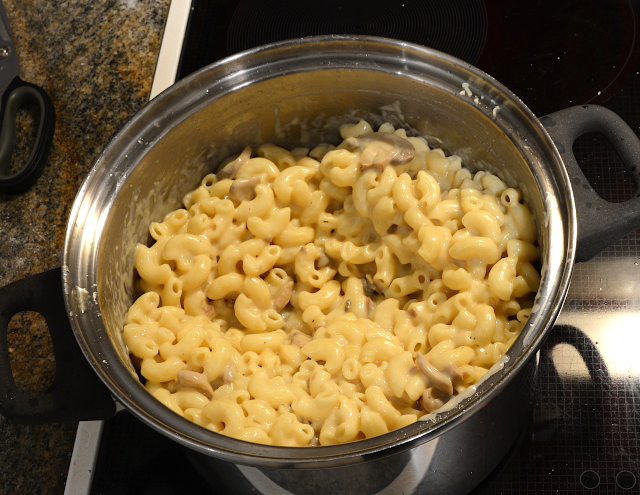

|
FourmiFoodHackeroni and Cheese |

|
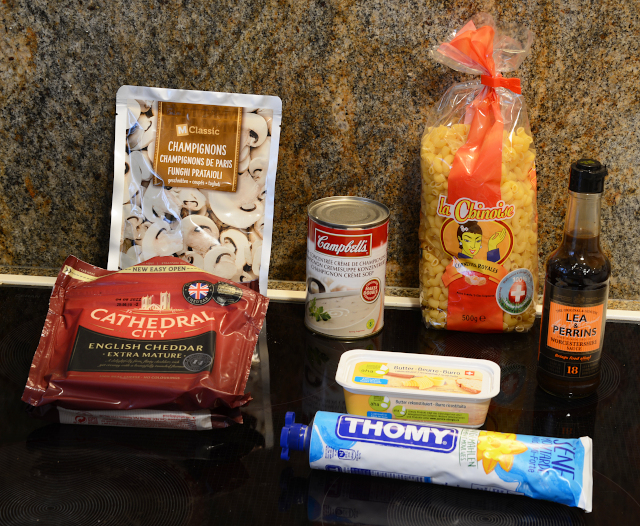
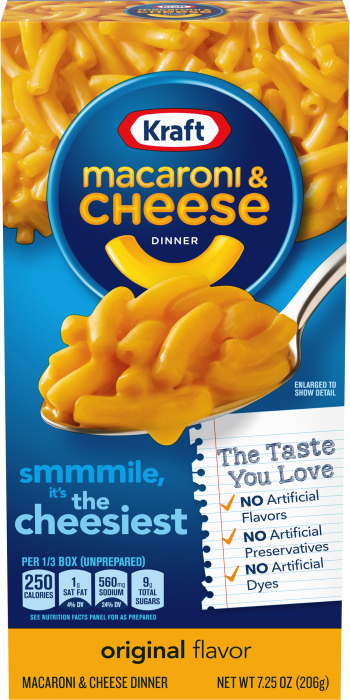 Like many impecunious and perpetually short on time programmers of my
generation, I made and ate many meals from the “blue box”—Kraft Macaroni
and Cheese Dinner—which, with the addition of a little bit of milk,
butter, and some water to boil the noodles, would serve up a perfectly
serviceable and tasty dish in a little more than ten minutes. The box
contained the noodles and powdered cheddar cheese, which melted
instantly when stirred into the cooked noodles, ready to eat. What's
more, all you had to clean up afterward was the noodle pan, the dish
you ate it from, and a spoon. Then, back to programming!
Like many impecunious and perpetually short on time programmers of my
generation, I made and ate many meals from the “blue box”—Kraft Macaroni
and Cheese Dinner—which, with the addition of a little bit of milk,
butter, and some water to boil the noodles, would serve up a perfectly
serviceable and tasty dish in a little more than ten minutes. The box
contained the noodles and powdered cheddar cheese, which melted
instantly when stirred into the cooked noodles, ready to eat. What's
more, all you had to clean up afterward was the noodle pan, the dish
you ate it from, and a spoon. Then, back to programming!
This was a staple of my diet all the time I lived in the U.S., even after I advanced to more ambitious cooking projects, some of which you will find here at FourmiFood. In the 1980s, I would even indulge in a frozen, microwaveable version of the same dinner, which was even faster, required no additional ingredients, and could be eaten out of the cardboard tray in which it was sold. (As far as I can tell, this product has since been discontinued.) I quickly figured out that the secret to enhancing the somewhat bland flavour of the standard product was adding outrageous amounts of mustard and Worcestershire sauce as well as a bit of salt and pepper, all of which could be done at the table, to taste. I never called it “Kraft Programmer Chow” at the time, but I should have.
From time to time, I was in the mood for something more fancy, and
so developed a recipe using canned condensed
cream of mushroom soup, elbow macaroni, grated cheddar cheese,
butter, sliced mushrooms, and the mainstay seasonings. After I moved
to Switzerland, where Programmer Chow is, sadly, unavailable,
home-made was the only option, and so this recipe, with much the
same flavour and consistency as the venerable blue box, has become
a mainstay. I call it…
Collect the ingredients. The quantities given make around four generously-sized servings.
I use “tbsp” (tablespoon) to mean 15 ml. None of these quantities needs to be exact, and you can add mustard, Worcestershire sauce, salt, and pepper at the table as you wish.
I normally use medium-sized elbow macaroni, but feel free to substitute any kind of pasta you prefer. When using other pasta, keep the weight constant, as the density of pasta varies with the shape and volume differs accordingly. Cheddar cheese comes in a multitude of varieties: mild, sharp, young, aged, smooth, crumbly, white, and orange. (The colour of orange cheddar is due to the addition of colouring agents, usually annatto seeds. This is purely a matter of tradition and customer expectations and makes little or no difference in taste. The cheddar I used in this example lacks this colouring and is the natural white colour from the milk.) If you'd like more mushrooms, double the quantity and if you prefer to forgo fungus, eschew them entirely.
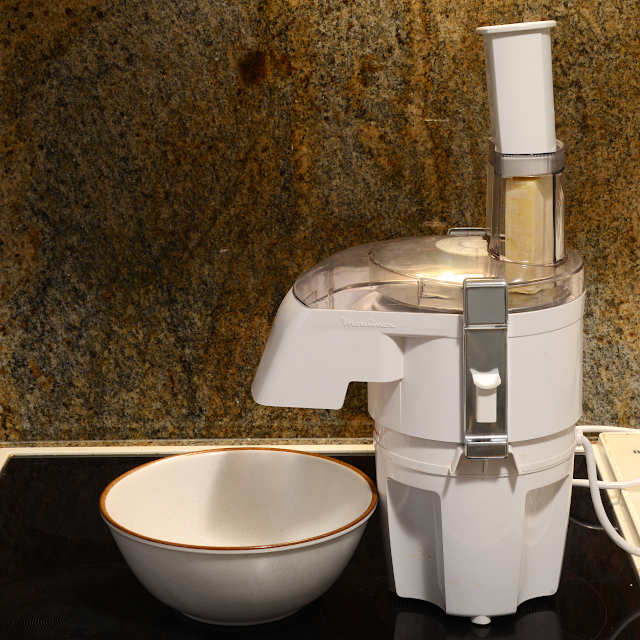
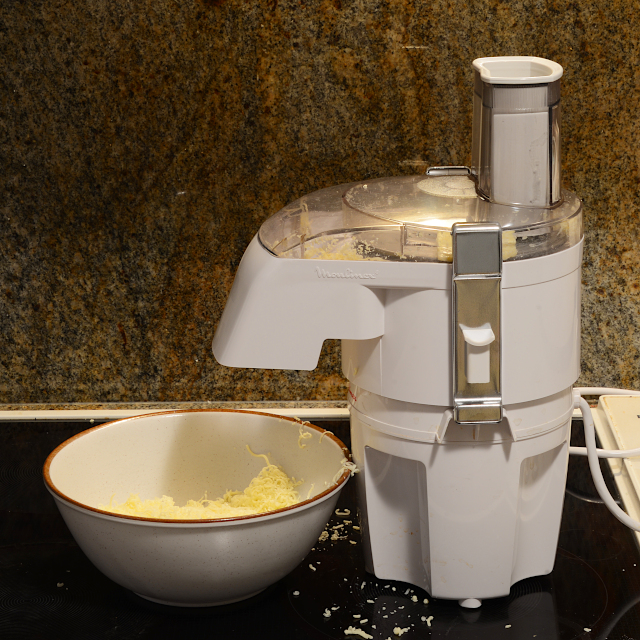
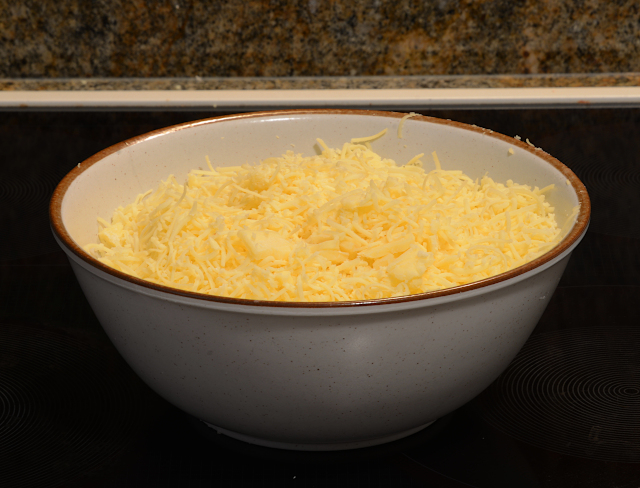 Start by grating the cheese. This allows it to melt more quickly and
avoids the risk of the fat separating if larger chunks of cheese take
too long to melt. You can do this with a “knuckle buster” or other
hand tool, but if you have a food processor with a grating disc, it
can be done in a matter of seconds. Just cut the blocks of cheese
into pieces that fit in the input chute and push them down into the
spinning grater. This tends to be a bit messy and takes a while to
clean up the food processor afterward, but it's much faster, makes
uniformly grated cheese, and avoids inadvertent seasoning of the
dish with blood you shed if you aren't having a grate day. The
grated cheese will take up a lot more room than the blocks you
started with, so be sure to use a big enough bowl for it.
Start by grating the cheese. This allows it to melt more quickly and
avoids the risk of the fat separating if larger chunks of cheese take
too long to melt. You can do this with a “knuckle buster” or other
hand tool, but if you have a food processor with a grating disc, it
can be done in a matter of seconds. Just cut the blocks of cheese
into pieces that fit in the input chute and push them down into the
spinning grater. This tends to be a bit messy and takes a while to
clean up the food processor afterward, but it's much faster, makes
uniformly grated cheese, and avoids inadvertent seasoning of the
dish with blood you shed if you aren't having a grate day. The
grated cheese will take up a lot more room than the blocks you
started with, so be sure to use a big enough bowl for it.
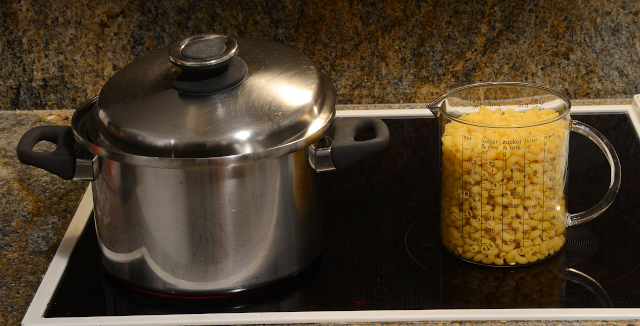
Fill a pot with around three times the volume of the pasta you're cooking (three litres for the quantity given above), add around one teaspoon of salt to flavour the pasta, and bring the water to a boil. Add the pasta to the boiling water carefully, stir to keep the bits from sticking together, start the timer for the cooking time recommended on the pasta package (8 minutes for the elbow macaroni shown), stir occasionally, and when the water resumes boiling reduce the heat until it's just boiling (adding heat beyond that point only wastes energy and steams up your kitchen—it doesn't make the pasta cook any quicker).
When the timer goes off, turn off the stove, remove the pasta from the heat, and drain in a colander. Do not rinse the pasta, but jostle it in the colander to encourage any water trapped in it to drain. Set the pasta aside to add later. You can now re-use the pot in which you cooked the pasta to make the sauce, to which we'll now turn.
(You can, if you wish, save time by cooking the pasta and preparing the sauce in parallel. You'll need two burners and pots, and have one more pot to clean when you're done, but if you're in a hurry and have already grated the cheese, there's plenty of time to make the sauce while the pasta is cooking, and you won't have to wait as long after mixing the pasta into the sauce for it to heat back up to serving temperature. I'd recommend deferring this optimisation until you've made the dish in serial fashion at least once, lest you get frazzled trying to do too many things at once.)
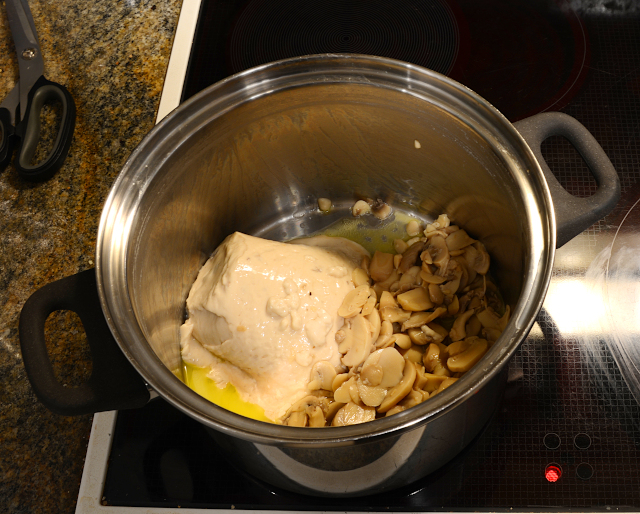 Dump the cream of mushroom soup, butter, mushrooms, salt, pepper,
mustard, and Worcestershire sauce into a pot large enough to eventually
hold the cheese and pasta when added later. Set the stove to
medium heat and, as the butter melts and soup liquefies, stir
everything together until all are evenly mixed.
Dump the cream of mushroom soup, butter, mushrooms, salt, pepper,
mustard, and Worcestershire sauce into a pot large enough to eventually
hold the cheese and pasta when added later. Set the stove to
medium heat and, as the butter melts and soup liquefies, stir
everything together until all are evenly mixed.
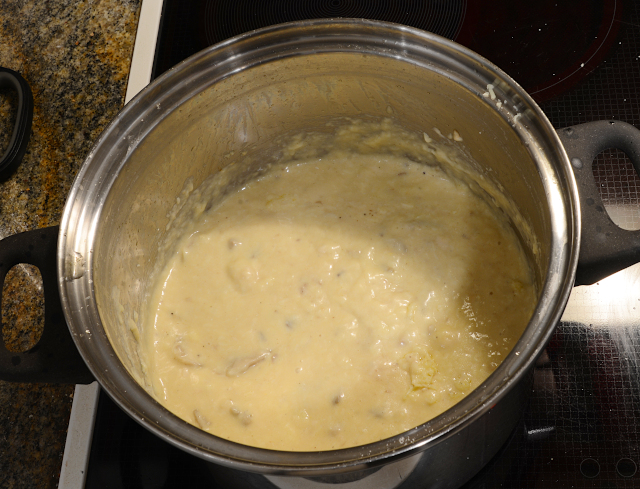 Before long, the sauce will be a uniform, crombobulating glozmo. You
don't want it to boil: if bubbles start to appear, reduce heat, stir
well, and scrape the bottom of the pot in case anything has begun to
stick.
Before long, the sauce will be a uniform, crombobulating glozmo. You
don't want it to boil: if bubbles start to appear, reduce heat, stir
well, and scrape the bottom of the pot in case anything has begun to
stick.
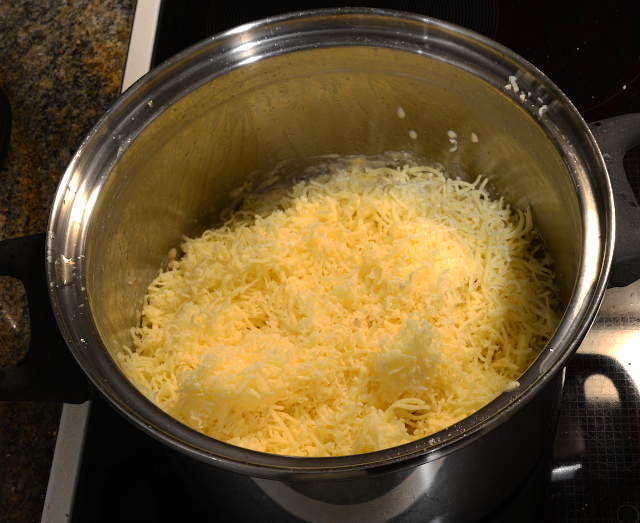 Now begin to add the grated cheese in batches (usually three or four)
which can be easily stirred into the sauce. Stir until each batch of
cheese is melted and lumps disappear before adding the next. Be sure
to scrape the walls and bottom of the pot to mix in any cheese which
may be hiding there.
Now begin to add the grated cheese in batches (usually three or four)
which can be easily stirred into the sauce. Stir until each batch of
cheese is melted and lumps disappear before adding the next. Be sure
to scrape the walls and bottom of the pot to mix in any cheese which
may be hiding there.
Once all of the cheese has been added to the sauce and is completely
melted to a smooth consistency, add the pasta from the colander, again
in batches, stirring each to mix with the sauce. It's best to use a
stiff spatula for this, which allows you to bring up sauce from the
bottom of the pot to mix in with the pasta you've added. When you
transfer a batch of pasta from the colander, take care that it doesn't
stick together and dump the whole mass of pasta in the pot and all of
its surroundings in one giant ker-blop.

After adding all of the pasta, continue to warm the pot until the pasta comes up to temperature, stirring occasionally and scraping the bottom to avoid sticking. And that's it!
Ladle out into bowls, with salt, black pepper, mustard, and Worcestershire sauce on the table for individual diners to add to their own taste preference. I find adding a lot of mustard and Worcestershire to this stuff only improves the taste, but others may disagree. I prefer to prepare it with a modest amount and then season to taste at the table.
If you have leftovers, remove from heat, cover the pot and let the contents cool to near room temperature, then pack into refrigerator boxes (I prefer serving-sized boxes that can be used individually when desired) and keep in the frigo. When you're ready to indulge again, dump a box into a dish, microwave for two or three minutes (depending upon the yield of your nuke), season as you wish, and enjoy.
Bon appetit!
If you're inclined to experiment, there are a lot of things to try and this is a dish which is very difficult to wreck. As I noted above, you can adjust the amount of mushrooms as you wish or leave them out entirely. A small amount of garlic purée or a mashed garlic clove added to the sauce will give it an edge. A very modest dash of hot sauce or cayenne pepper will add a little bite. For a major difference in the taste and consistency, experiment with different cheeses, not just different varieties of cheddar, but also further afield. For years, when cheddar was not reliably available in Switzerland, I made this recipe with “moitié-moitié” fondue cheese, a mix of Gruyère and Fribourg Vacherin cheese, sold in supermarkets, already grated, in packages of 400 grams. To add some crunchiness and an interesting flavour twist, add one small finely-chopped onion to the sauce either instead of or in addition to the mushrooms.
If you search the Web for macaroni and cheese recipes, you will find hundreds, if not thousands, with ingredients ranging from bread crumbs, eggs, flour, evaporated milk, vinegar, Vegemite (ewwww!), diced ham or chicken, and broccoli; with preparation ranging from quick and easy one-pot stovetop recipes like this one to baked extravaganzas that take an hour or more to make. This one does the trick for me (I liked Programmer Chow!), and it's true to the original in flavour, texture, preparation time, and minimal clean-up in the aftermath. But cooking is an experimental art so, if you're inclined, go wild.